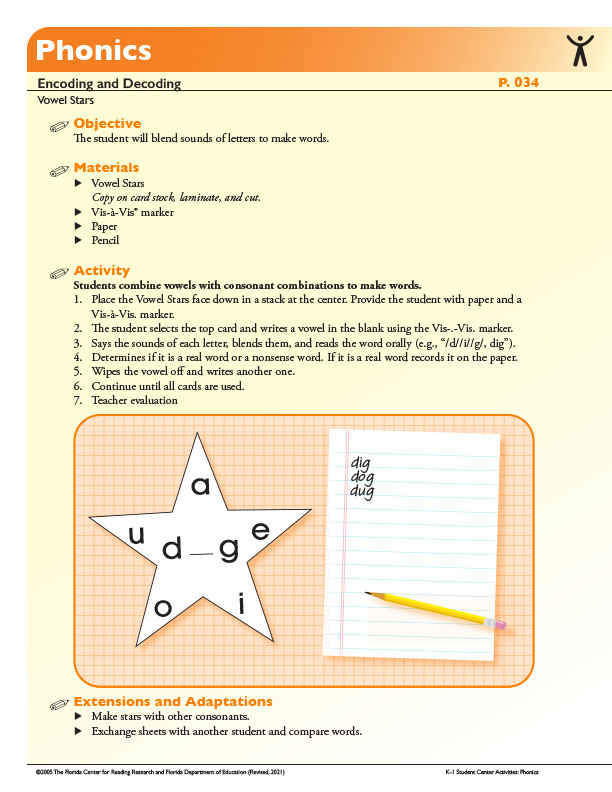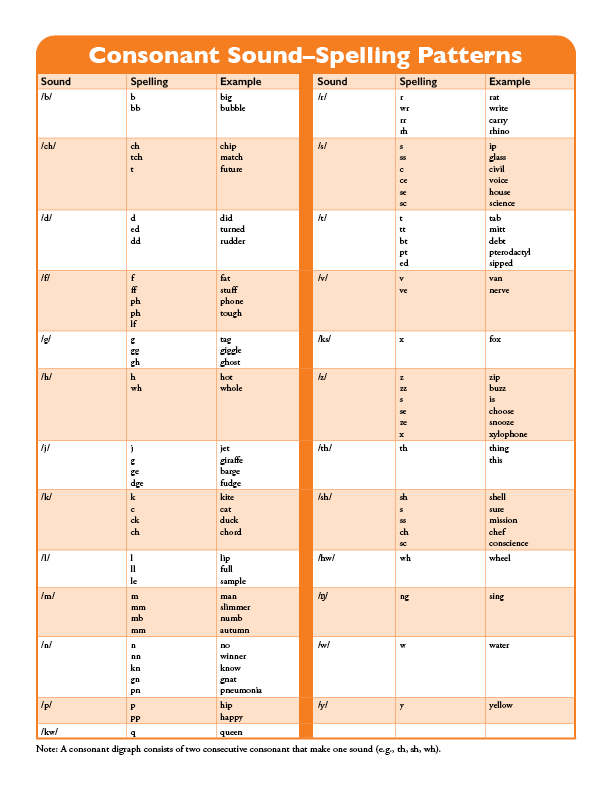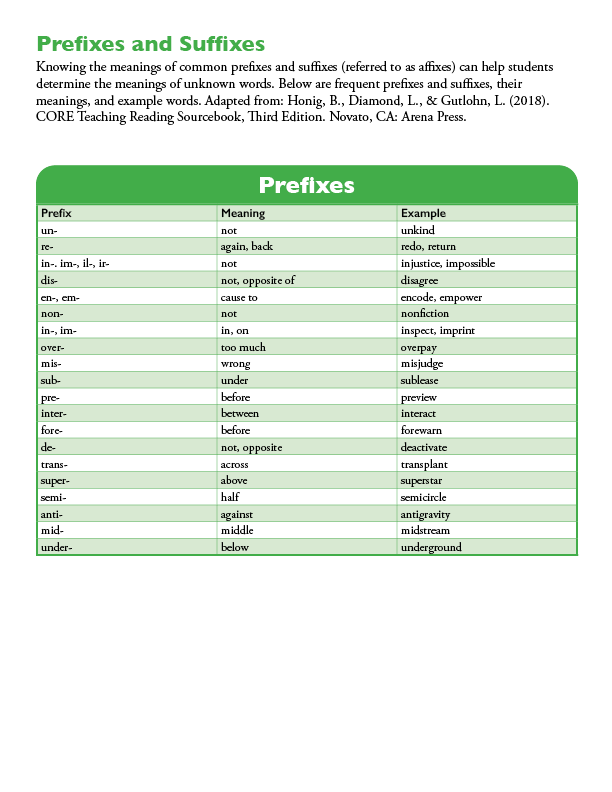This Teacher Resource Guide accompanies K-5 Student Center Activities developed by the Florida Center for Reading Research in partnership with the Florida Department of Education. It is designed to support teachers in differentiating instruction by using the Student Center Activities (SCAs) that support building foundational reading skills.
The Student Center Activities (SCAs) were designed for teachers to use when implementing reading centers in the classroom. They are not intended to be a curriculum. Rather, SCAs can be used to supplement instruction that is aligned to standards and curricula already being used in the classroom. Teacher’s should use their student’s performance data to make decisions about which activity to use and how to implement them in the classroom.
Systematic and Explicit Instruction
The Student Center Activities were designed to help teachers provide systematic and explicit instruction.
Systematic instruction includes the direct presentation of skills and concepts in a pre-specified sequence taught in a logical, defined order that builds on prior learning. For example:
- Skills and concepts begin with simple and move to complex.
- Student objectives are clear, concise, and driven by ongoing assessment results.
- Students are provided with appropriate practice opportunities which directly reflect explicit instruction.
Explicit instruction includes instructional routines that consist of teacher modeling, guided practice, supported application, and independent practice. For example:
-
Teacher models and explains the Activity
Some activities need repeated modeling, while others need to be modeled only one time. For example, a syllable segmenting activity may be modeled once at the teacher-led center and then placed at a student center. Teaching students how to identify the meanings of words in context may require many whole group lessons in addition to modeling at the teacher-led center before being placed at a student center. View an example:
-
Teacher provides Guided Practice
Students practice what the teacher models and the teacher provides prompts and feedback. View an example:
-
Teacher provides Supported Application
Students apply the skill as the teacher scaffolds instruction. View an example:
-
Independent Practice
Students apply the skill independently. View an example:
What is differentiated instruction?
Differentiated instruction is matching instruction to each student’s individual needs and abilities. This can be accomplished by the teacher working with an individual or with a small group of students. Having a clear, systematic, instructional plan helps the teacher know when to shift the plan, or differentiate instruction, for some students. For example, when students do not master the content after initial instruction, the teacher may need to slow down the pace, repeat some lessons, and/or intensify instruction by teaching in smaller groups to provide students more opportunities to practice with teacher feedback.
A critical factor of successfully differentiating instruction is to focus on the individual needs of students. This is best achieved in small groups where teachers can focus on specific skills and scaffold instruction on a more individualized basis than can be accomplished in a whole group setting. To teach in small groups, the teacher must be able to work uninterrupted and be assured that the students who are not in that small group are spending their time productively.
Implementing reading centers is an effective way to differentiate instruction because it provides time for a teacher to meet the diverse instructional needs of all students. During reading center time, the teacher works with small groups of students at the teacher-led center while the other students practice, demonstrate, and extend skills independently at the student centers. This is an ideal time to keep all students actively and academically engaged. Intervention delivered by classroom teachers or other reading specialists can also be implemented during this time.
Reading Centers
Reading centers are places where students practice, demonstrate, and extend learning independent of the teacher or with the assistance of the teacher. Reading centers are special places organized in the classroom for students to work in small groups, pairs, or individually. Each center contains meaningful, purposeful activities that are a reinforcement and/or extension of what has already been taught by the teacher in reading groups or in whole group. All reading center activities focus on and reflect the content of reading instruction and require careful planning.
Read more
Reading centers provide a way for students who are not working with the teacher to be academically engaged in meaningful and independent activities. When the activities placed at centers and expected behaviors have been explicitly taught and practiced well, all students will be academically engaged whether working at independent student centers or at the teacher-led center. Implementing reading centers in an organized classroom can be an efficient and effective way to provide all students
- explicit, differentiated reading instruction;
- engaging opportunities to practice foundational reading skills; and
- hands-on, targeted opportunities that reinforce and are aligned with previously taught skills.
Students practice a variety of skills at reading centers. For example, they practice phonics skills at the phonics center; they explore and apply knowledge of word meanings at the vocabulary center; they read books, listen to recorded books, record the reading of a book, and read in pairs at the fluency center. Another example is the library/research center which contains a variety of resources like dictionaries and articles. Activities and materials at reading centers may consist of building words using magnetic letters, writing and spelling using a whiteboard, and sequencing stories using sentence strips and pocket charts. Some reading centers may be permanent; others will change according to the skills, books, and activities currently addressed.
Keep in mind that reading centers are places in the classroom where students go to work; some teachers prefer to keep the types of reading centers consistent, and others prefer to vary them. As long as the reading centers are managed in an organized fashion with clear expectations, either way may be effective.
A teacher-led center is a place where a small group of students participate in a lesson led by the teacher. Here, based on student assessment data, the teacher explicitly teaches new skills and concepts and guides students in practice with previously taught skills. Instruction at the teacher-led center allows the teacher to provide a small group of students with immediate corrective feedback, scaffolded instruction, and practice with targeted skills.

A student center is a place in the classroom where students work, independent of the teacher, in small groups, pairs, or individually to practice, demonstrate, and extend learning. Typically, students work at student centers while the teacher is conducting small group instruction at the teacher-led center. Each student center contains meaningful, purposeful activities that are a reinforcement and/or an extension of what has already been explicitly taught by the teacher during small- or whole-group instruction.
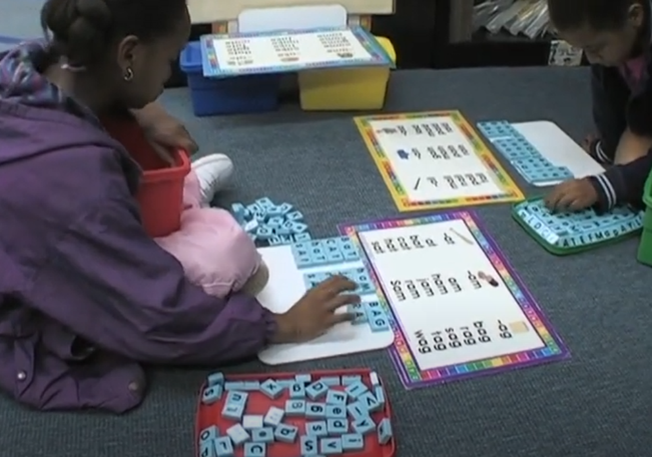
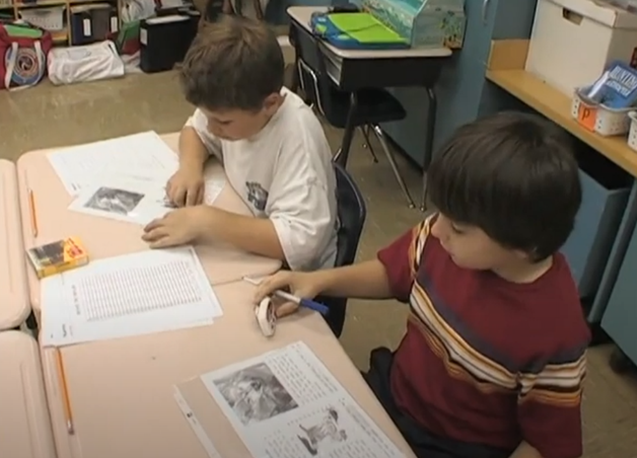


Examples of reading centers and aligned activities are in the table below. The activities are from the Student Center Activities (SCA) developed by the Florida Center for Reading Research.
| Example Center | Example Student Center Activity | Grade Level |
|---|---|---|
| Phonological Awareness Center | PA.030 Phoneme Dominoes Students match pictures with the same initial sound while playing a domino game. | K-1 SCA |
| PA.023 Phoneme Swap Students decide which phoneme has been changed by comparing two pictures. | 2-3 SCA | |
| Phonics Center | P.035 Word Steps Students make new words by changing one letter using letter cards. | K-1 SCA |
| P.021 Jar Sort Students identify and sort words with r-controlled vowels into corresponding sound-spelling jars. | 2-3 SCA | |
| AP.015 Inflection Reflection Students read multisyllabic words by isolating prefixes and suffixes. | 4-5 SCA | |
| Fluency Center | F.005 Fluency Letter Wheel Students say sounds of letters on a spinner in a timed activity. | K-1 SCA |
| F.025 Read and Read Again Students time repeated readings and graph words correct per minute. | 2-3 SCA | |
| F.024 Fluent Reflections Students read text and self-evaluate reading performance. | 4-5 SCA | |
| Vocabulary Center | V.012 Multiple Meaning Bugs Students identify multiple meanings of words while making bugs. | K-1 SCA |
| V.029 Analogy Action Students complete analogies playing a completion game. | 2-3 SCA | |
| V.026 Word-by-Word Students show relationships among the meaning of words by placing them on a continuum. | 4-5 SCA | |
| Comprehension Center | C.010 Story Sequence Organizer Students write or draw the main events of a story in sequential order using a graphic organizer. | K-1 SCA |
| C.020 Cause and Effect Match Students identify causes and corresponding effects by playing a matching game. | 2-3 SCA | |
| C.028 More Incredible Inferences Students identify inferences by reading clues. | 4-5 SCA |
Setting Up Reading Centers
Here are some guidelines for creating effective reading centers:
Read more
- Start with the student; plan what reading center to create with the student in mind.
- What knowledge do students have as readers or writers?
- Will they be able to work independently and/or collaboratively at the center?
- Think about ways to make the center engaging and motivating for all students.
- Think of the materials and the students' reading and writing levels.
- What will the student's role be?
- What will your role be?
- Think about the purpose of the reading center.
- Identify where to create the reading center.
- Choose a theme, topic, or focus for the center.
- Decide on how you will organize resources and materials at the reading center.
- Make a list of directions explaining how students should use the center.
- Teach students how to use the center; monitor their understanding of its use and provide feedback as needed.
- Monitor student participation in the center (develop a system [e.g., a checklist] for tracking it).
- Create routines for students to use while at the center.
Examples of reading centers:
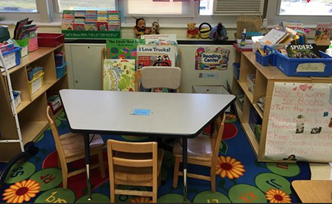

Implementing Reading Centers Using the Student Center Activities
The Student Center Activities (SCAs) are intended to provide students opportunities to practice, demonstrate, and extend their knowledge of previously taught reading skills. Implementing the SCAs in a well-managed classroom allows the teacher to differentiate instruction in small groups while the students at centers spend their time productively. Each SCA is explicitly taught before students use them independently. Assessment data should guide the teacher’s decisions about which SCA to use, when, and with whom.
The following eight elements can assist teachers in implementing reading centers in the classroom. Each element is intentionally planned before implementation.
Form Flexible Groups Based on Assessment
Although there is not one right way to form small groups for reading centers, there are things to consider when forming small groups for the teacher-led center and for student centers. The teacher forms small, flexible groups based on assessment data and observations.
For the teacher-led center, small groups are formed to meet each group’s specific instructional needs and are kept flexible, which means they change (based on instructional need) in terms of
- membership of each group—students change groups based on instructional need;
- content of the lesson (i.e., area(s) of reading skill and level of instruction);
- size of each group—keep group sizes small (5-7 students as a maximum) and reduce the group size to 3-5 for students in need of intensive support;
- number of days per week each group attends the teacher-led center (e.g., daily, twice per week, 3 times per week); and
- number of minutes per day (e.g., 10 minutes, 20 minutes, 30 minutes, etc.).
For student centers:
- base small groups on instructional need of specific reading skills.
- consider attitudes, behaviors, and work ethics of each student.
- monitor the progress of high risk students more frequently in order to make instructional changes, small group changes, and to accelerate learning.
- determine if students will stay in the same teacher-led center group or if they will be assigned to a different group.
Select Activities Based on Assessment
- Choose activities for student centers that target each group’s instructional need. If students stay in the same groups throughout center time, the activities will be at the same skill level within each group. If students are at different skill levels at student centers, use the extensions and adaptations in each SCA to differentiate the activity at each center. Within each student center, students are all academically engaged: working individually, in pairs, or as a small group.
- Plan with the learning objective, not the product, in mind. The goal of implementing reading centers is to advance student reading ability.
- Time must also be a consideration. If you have allotted 20 minutes for the center and the activity only requires 10 minutes, the students will need something else to do for additional practice on the skill addressed in the activity. Suggestions for extensions and adaptations are provided in each SCA. Continuous support materials (such as puzzles, letter stamps, magnetic letters and boards, etc.) should be available at each center for use when students finish a specific activity.
Design Center Management System
Center management systems establish classroom routines, protect valuable instructional time, and help coordinate:
- group formation,
- activities,
- center locations/areas,
- systematic movement of student groups, and
- scheduling of reading center times.
Center management visuals are graphic organizers and may be displayed in a variety of ways. Center management visuals help students know where they should be, when they should be there, and what they should be doing. This allows the teacher to concentrate on instruction at the teacher-led center and emphasizes accountability from students. The center management visual should:
- meet the needs of the management system,
- be large enough to be seen by all students from different areas of the room,
- match words and pictures to those at the center areas to help students quickly locate centers, and
- support students to independently determine where they should be.
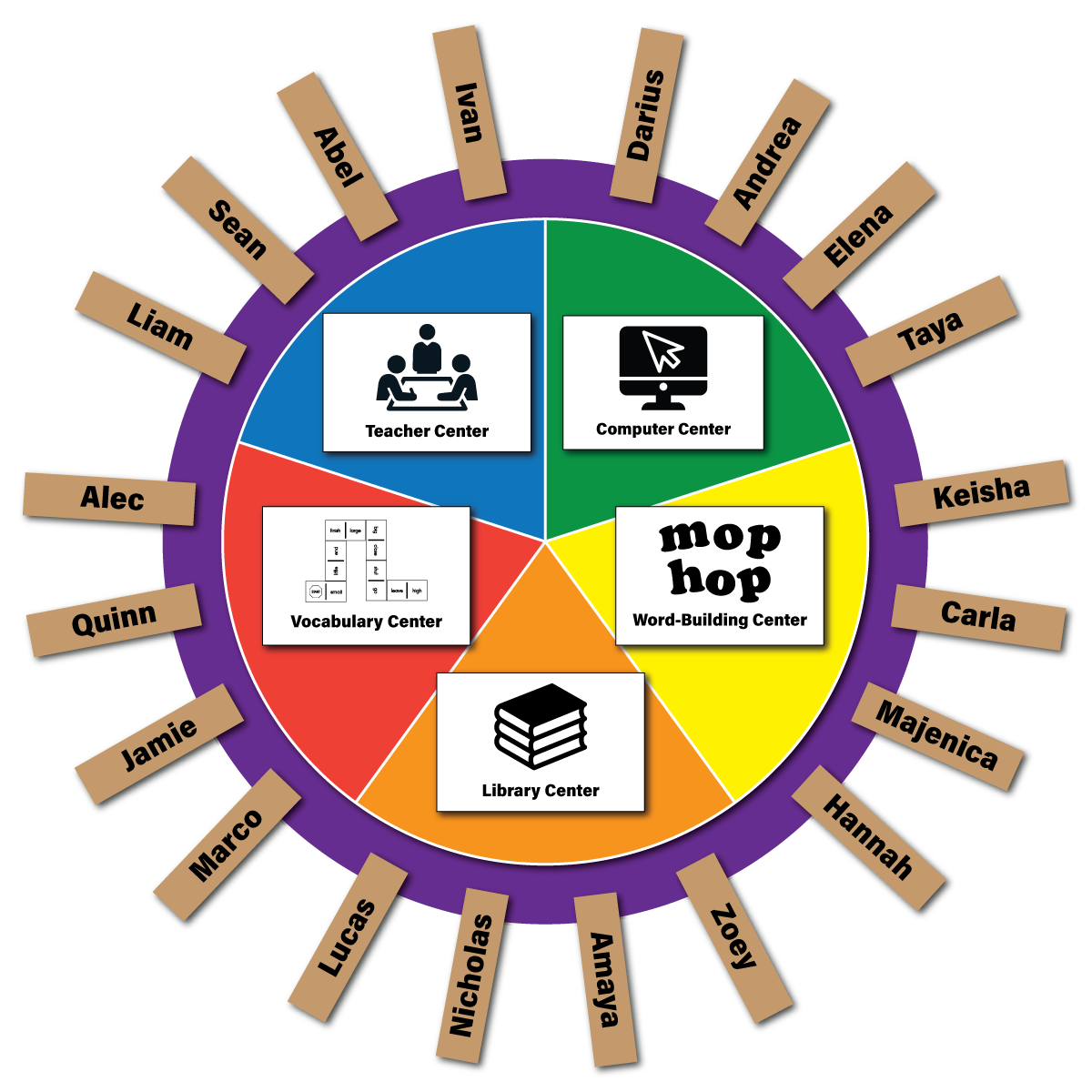
This center management visual is a rotation wheel which consists of two circles—one large and one smaller. Student names are on clothespins and placed in groups on the larger laminated circle. Student clothespins may be moved as groups change. Using Velcro, center icons are placed on the smaller laminated circle and may be replaced as centers change. Turn the larger wheel to rotate centers. This example shows four centers including the teacher-led center.
Provide Explicit Instruction
The goal of explicit instruction is to help students understand what they are expected to accomplish at a specific center. Clear directions and expectations encourage academic engagement at centers. It is essential to model each activity before students are expected to complete it at the center. Providing directions in manageable steps helps students to understand the sequence of completing an activity. Model the use of new materials and activities before placing them in a center either during the whole group lesson or at the teacher-led center.
Activities to be completed at centers should be introduced by the teacher in the following format:
- Teacher Models and Explains the Activity
Some activities need repeated modeling, while others need to be modeled only one time. For example, a syllable segmenting activity may be modeled once at the teacher-led center and then placed at a student center. Teaching students how to identify the meanings of words in context may require many whole group lessons in addition to modeling at the teacher-led center before being placed at a student center.
- Teacher provides Guided Practice
Students practice what the teacher models and the teacher provides prompts and feedback.
- Teacher provides Supported Application
Students apply the skill as the teacher scaffolds instruction.
- Independent Practice
Students apply the skill independently.
This same format (steps 1-4) should also be used to teach students how to use the manipulatives and/or technology (e.g., computer, timer, media player) at each center.
Implement a Behavior Management System
It is critical to spend time at the beginning of the school year modeling, practicing, and reviewing appropriate classroom procedures in order to establish time efficient routines and to encourage positive classroom behaviors. It may take at least six weeks to implement student centers before beginning teacher-led centers (more so in the primary rather than intermediate grades). During this time, the teacher should be monitoring students and providing assistance and feedback as needed. It can also be helpful to send students to one center daily until they “get the hang of it” before trying two or three centers daily. Implementing an effective behavior management system may require a large amount of time initially; however, this is a productive use of time for two important reasons:
- Students need to be on-task in order for reading centers to support learning.
- The teacher needs to focus on students at the teacher-led center and this is not possible if the other students are off-task.
When teachers implement a behavior management system, students should be involved in role modeling positive classroom behaviors. Boundaries and consequences should be fair, consistent, and age-appropriate. Throughout the year, teachers may want to occasionally use the teacher-led center time to circulate during student centers to support on-task behavior. If this is the case, all students go to student centers while the teacher monitors and provides feedback as needed. Successful implementation of student centers involves helping students know how to problem solve. For example, students need to know:
- what to do when something does not work,
- what to do when they do not understand the activity at a center,
- what to do when they complete an activity at a center,
- whom to go to for help (e.g., “Ask 3 before you see me.”),
- how to clean up (where to put their product, where to put materials away, etc.), and
- how to decide who goes first when engaged in a pair or group activity.
Teachers have found that creating a chart or checklist with their students is an effective way to ensure positive classroom behavior. These charts or checklists include the expected student behavior at each center. The checklist and center management visual provide a management system that supports on-task student behavior. Teachers will:
- review the rules and consequences,
- facilitate student practice of classroom procedures,
- make consequences meaningful,
- be consistent when implementing the behavior management system, and
- hold all students accountable.
It is important that students continuously practice classroom routines until the centers and transfers are running smoothly. Even in the best managed classrooms, students may not be academically engaged at student centers. If this is the case, teachers can self-reflect using questions such as:
- Did I introduce too many new centers at once?
- Did I do an effective job explicitly teaching the activity?
- Have students mastered the skill and need to move on?
- Is the activity interesting to the students?
- Do these students work well together?
- Is the activity too difficult for students to do independently?
Answering these questions may help teachers reorganize centers and get students back on track. It may also be helpful to have a problem-solving discussion with the students about certain centers or activities.
Organize the Classroom
The goal of creating an organized classroom is to obtain maximum student time on task. Keeping an organized classroom enables students to easily locate materials, focus on academic tasks, and use reading center time productively.
Clearly define, organize, and label reading centers to facilitate the flow of student movement. Set center materials in an orderly arrangement, allowing adequate work space for each student. Place skill leveled materials in containers (for example, baskets) and label accordingly. Also, preserve and protect materials by laminating or using another creative method so that they don’t have to be remade. Teach students how to keep materials organized, replace materials when needed, and clean up in an orderly and timely manner. When materials are well organized and students cooperate in taking care of centers, classroom disruptions are limited. Suggestions for preparing SCAs:
- Copy on cardstock or laminate non-consumable materials when feasible.
- Glue picture, letter, and word cards on construction paper or cardstock.
- Organize and store (e.g., envelopes, plastic baggies, plastic bins) materials together for each SCA.
- Copy, laminate, and place at centers the Activity Steps and/or the Example from the SCA to remind students how to complete the activity.
Manage Transfers
Managing transfers maximizes and protects instructional time. It is important to keep a quick pace when transferring between centers. Instill consistent classroom routines and expectations for changing centers, putting materials away, and cleaning up center areas. There are a variety of signals that may be used to indicate to students that it is time to change centers. You can also use transfer time instructionally to reinforce skills. For example, recite poems, sing songs, or play word games while the students clean up.
Use Accountability
Accountability is a way to encourage students to stay academically engaged and for teachers to determine whether or not students can apply what they have been taught. Accountability should be established for activities at all centers. Communicate the fact that students are expected to stay on task and complete quality work. Students need to receive feedback in a timely manner. Reviewing center work daily:
- prevents students from practicing the same errors,
- provides opportunities for teachers to instill the importance of quality work, and
- conveys the importance of each academic task.
Establishing accountability is intended to help students develop an appreciation for learning and to view reading centers as a meaningful and productive time of day. Other key ideas to keep in mind concerning accountability:
- The process of learning to be proficient readers is more important than creating a product at each center. Students need to be accountable for work completed at centers, but this does not mean there always needs to be a product.
- Have “with-it-ness” — even though teachers are involved with other students in a small group at the teacher-led center, they must be aware of what is going on at the student centers. This is a teaching skill that comes with time and practice!
Five Components of Reading Instruction
The Student Center Activities (SCAs) include critical skills that consistently relate to reading success and are organized by five components of reading instruction: phonological awareness, phonics, fluency, vocabulary, and comprehension.
Phonological Awareness
Phonological awareness is the understanding that spoken language can be broken down into parts and the ability to manipulate those parts at the word, syllable, onset-rime, and phoneme level. Phonemic awareness is the ability to notice, think about, and work with the individual sounds in spoken words. Phonemic awareness is a developmental level of phonological awareness. Think about the size of the unit of language you are focusing on--if you are working with a broad focus of words or syllables it is phonological awareness. If you are working with a narrow focus of individual sounds (phonemes), it is phonemic awareness. The ultimate goal of phonological awareness instruction is to help students develop an awareness that words are composed of individual sounds, or phonemes, and to develop the ability to manipulate individual sounds in words. Phonological awareness helps students benefit more from phonics instruction and is directly related to reading ability.
Sequence of the Phonological Awareness Student Center Activities (SCA) Across Grade Levels
Progress monitoring data and teacher observation determine the order of SCA implementation and who engages in which SCA. Here is the sequence, from simple to complex, of the subcomponents of the phonological awareness activities across the grade levels.
| K-1 SCA | 2-3 SCA | 4-5 SCA |
|---|---|---|
| Rhyme Alliteration Sentence Segmentation Syllable Onset and Rime Phoneme |
Phoneme Matching Phoneme Isolating Phoneme Blending Phoneme Segmenting Phoneme Segmenting and Blending Phoneme Manipulating |
Phonological awareness is typically achieved by fourth grade. If a student has not yet learned to decode words, then some phonemic awareness instruction in conjunction with phonics (to reinforce the alphabetic principle) may be needed. |
Phonics
Phonics is the relationship between graphemes (letters) and the phonemes (sounds) they represent. Phonics is also used to describe reading instruction that teaches these relationships (often referred to as sound-symbol correspondences). The goal of phonics instruction is to help children use sound-symbol correspondences to read and write words.
Phonics instruction helps students learn the alphabetic principle (the understanding that there are systematic and predictable relationships between written letters and spoken words). This helps students learn to read familiar words with accuracy and decode unknown words. This process proves true for regular (e.g., mat) and irregular (e.g., phone) words. Once students are able to read words quickly, their reading becomes more fluent, and they can spend more cognitive energy on comprehension, and less on decoding words.
Sequence of the Phonics Student Center Activities (SCA) Across Grade Levels
Progress monitoring data and teacher observation determine the order of SCA implementation and who engages in which SCA. Here is the sequence, from simple to complex, of the subcomponents of the phonics activities across the grade levels.
| K-1 SCA | 2-3 SCA | 4-5 SCA |
|---|---|---|
| Letter Recognition Letter-Sound Correspondence Onset and Rime Encoding and Decoding High-Frequency Words Variant Correspondences Syllable Patterns Morpheme Structures |
Letter-Sound Correspondence High-Frequency Words Variant Correspondences Syllable Patterns Morpheme Structures |
Variant Correspondences Syllable Patterns Morpheme Structures |
Fluency
Fluency is the ability to read out loud accurately, at an appropriate rate, and with expression (including appropriate pausing and oral interpretation of the text). Fluency emerges gradually over time through supported and repeated practice in automatic word recognition. The successful development of fluency depends on an individual acquiring phonemic awareness, accurate letter-sound correspondence, sound blending, and spelling pattern and morpheme recognition. In addition, oral reading practice with feedback from the teacher is necessary. The goal of fluent reading is to improve comprehension through the ability to recognize words automatically, accurately, and with prosody (proper phrasing, intonation, and expression). When students identify words accurately and automatically, they can concentrate on comprehending the text rather than decoding words.
Sequence of the Fluency Student Center Activities (SCA) Across Grade Levels
Progress monitoring data and teacher observation determine the order of SCA implementation and who engages in which SCA. Here is the sequence, from simple to complex, of the subcomponents of the fluency activities across the grade levels.
| K-1 SCA | 2-3 SCA | 4-5 SCA |
|---|---|---|
| Letter Recognition Letter-Sound Correspondence Words Connected Text |
Letter-Sound Correspondence Word Parts Words Phrases Chunked Text Connected Text |
Word Parts Words Phrases Chunked Text Connected Text |
Vocabulary
Vocabulary refers to knowledge about the meanings, uses, and pronunciation of words. Vocabulary is often categorized as oral vocabulary (listening and speaking) and print vocabulary (reading and writing). The goal of vocabulary instruction is to provide students with an understanding of the meaning and use of words so that they can comprehend what they are reading and communicate effectively.
Sequence of the Vocabulary Student Center Activities (SCA) Across Grade Levels
Progress monitoring data and teacher observation determine the order of SCA implementation and who engages in which SCA. Below is the sequence, from simple to complex, of the subcomponents of the vocabulary activities across the grade levels. Words used in these vocabulary SCAs were selected from grade level lists. Teachers are encouraged to adapt these SCAs by using vocabulary words that are relevant and appropriate for their students.
| K-1 SCA | 2-3 SCA | 4-5 SCA |
|---|---|---|
| Word Knowledge Morphemic Elements Word Meaning Word Analysis Words in Context |
Word Knowledge Morphemic Elements Word Meaning Word Analysis Words in Context |
Word Knowledge Morphemic Elements Word Meaning Word Analysis Words in Context |
Comprehension
Reading comprehension refers to the understanding of the meaning of a passage and the context in which the words occur. Reading comprehension depends on various underlying components including decoding (the ability to translate words in print into speech), knowledge of word meanings (vocabulary), fluency, the ability to understand and interpret spoken language, and knowledge of text structure. Skills that support the development of reading comprehension include both language-comprehension skills as well as word-reading skills. Difficulty in word-reading limits reading comprehension in the early stages of learning to read. However, as word-reading skills become more fluent across the grade levels, students rely more on language comprehension to comprehend what is read. The goal of comprehension instruction is for students to gain understanding from written language.
Sequence of the Comprehension Student Center Activities (SCA) Across Grade Levels
Progress monitoring data and teacher observation determine the order of SCA implementation and who engages in which SCA. Below is the sequence, from simple to complex, of the subcomponents of the comprehension activities across the grade levels.
| K-1 SCA | 2-3 SCA | 4-5 SCA |
|---|---|---|
| Sentence Meaning Narrative Text Structure Expository Text Structure Text Analysis Monitoring for Understanding |
Narrative Text Structure Expository Text Structure Text Analysis Monitoring for Understanding |
Narrative Text Structure Expository Text Structure Text Analysis Monitoring for Understanding |


